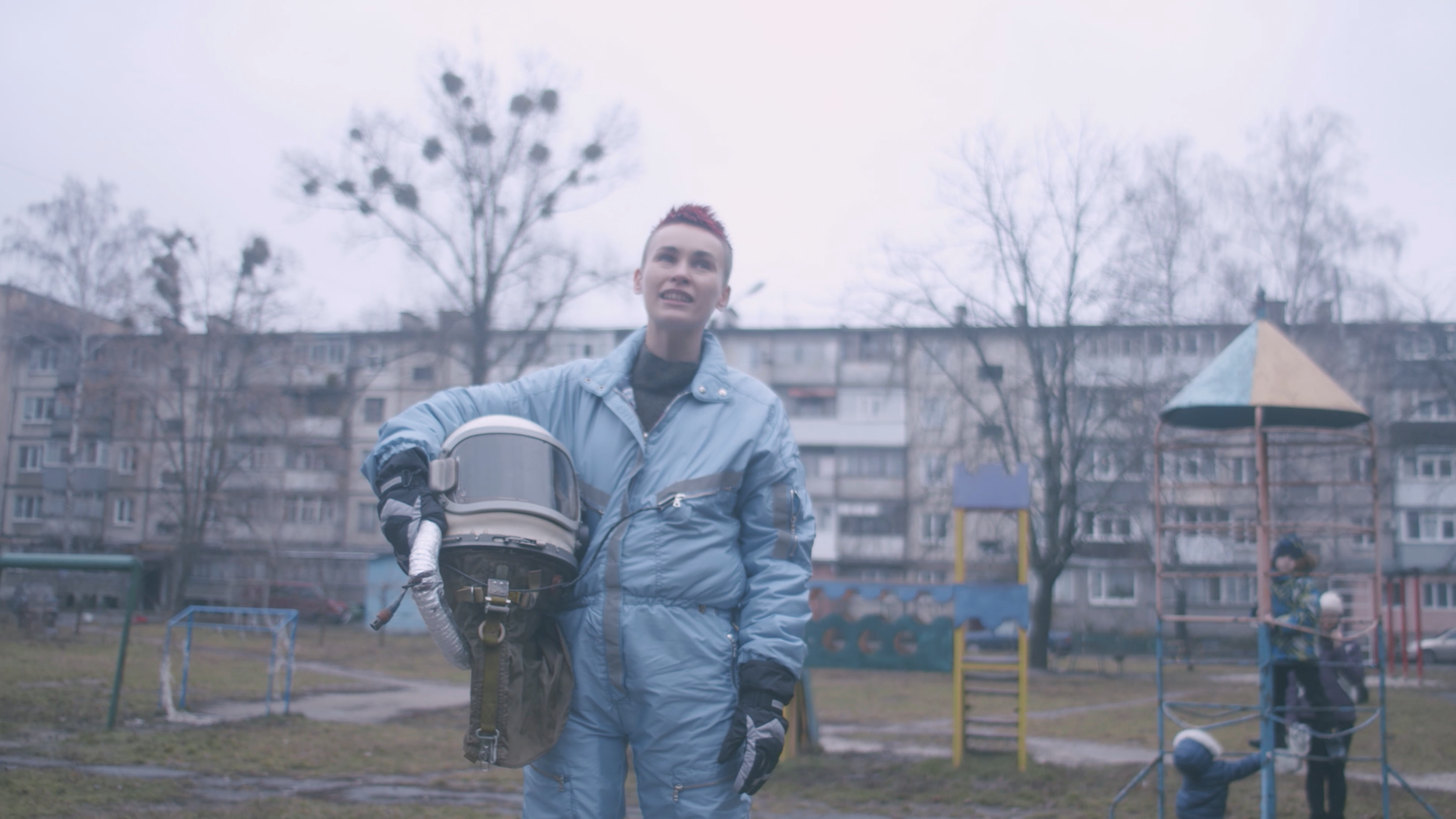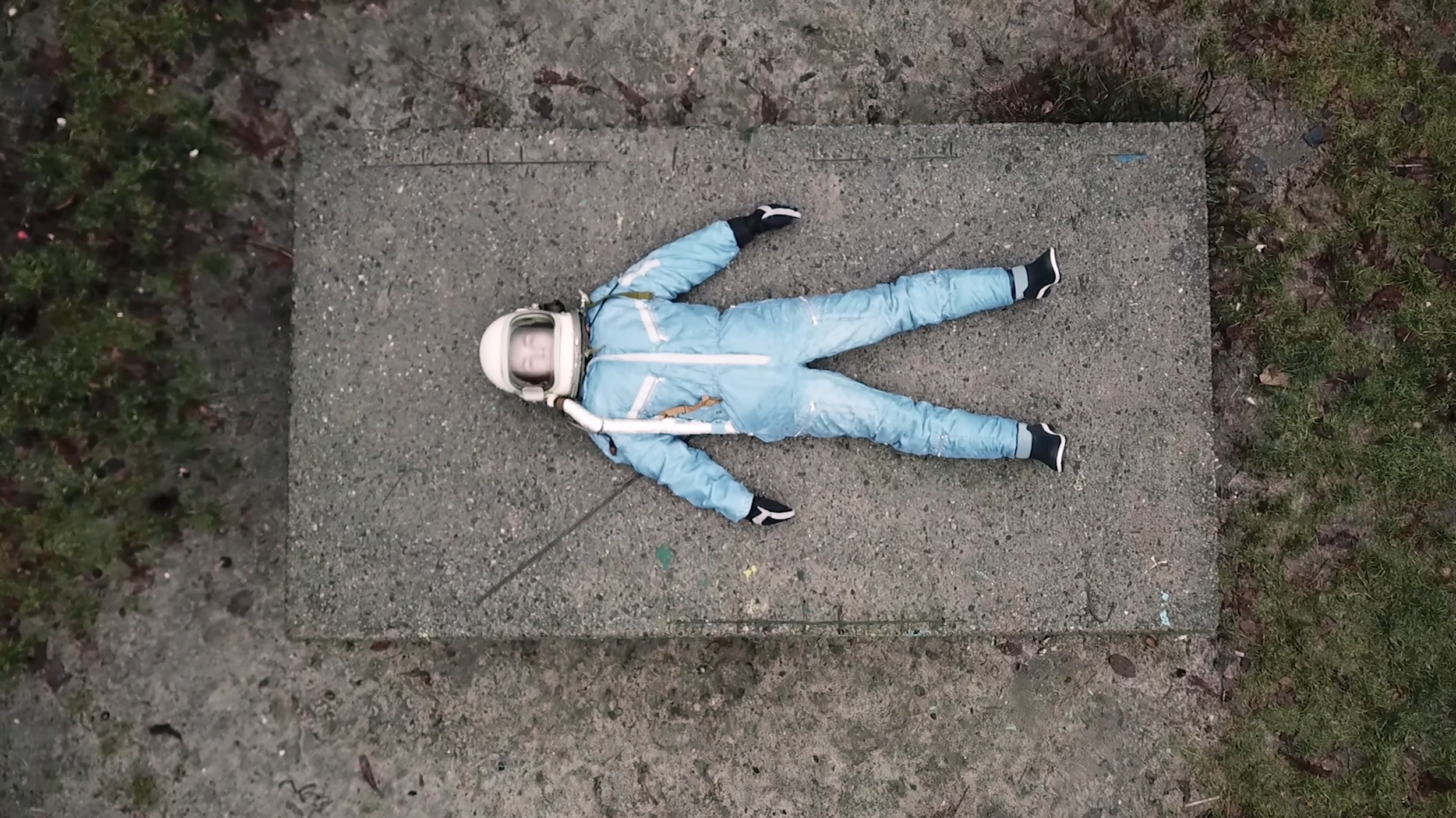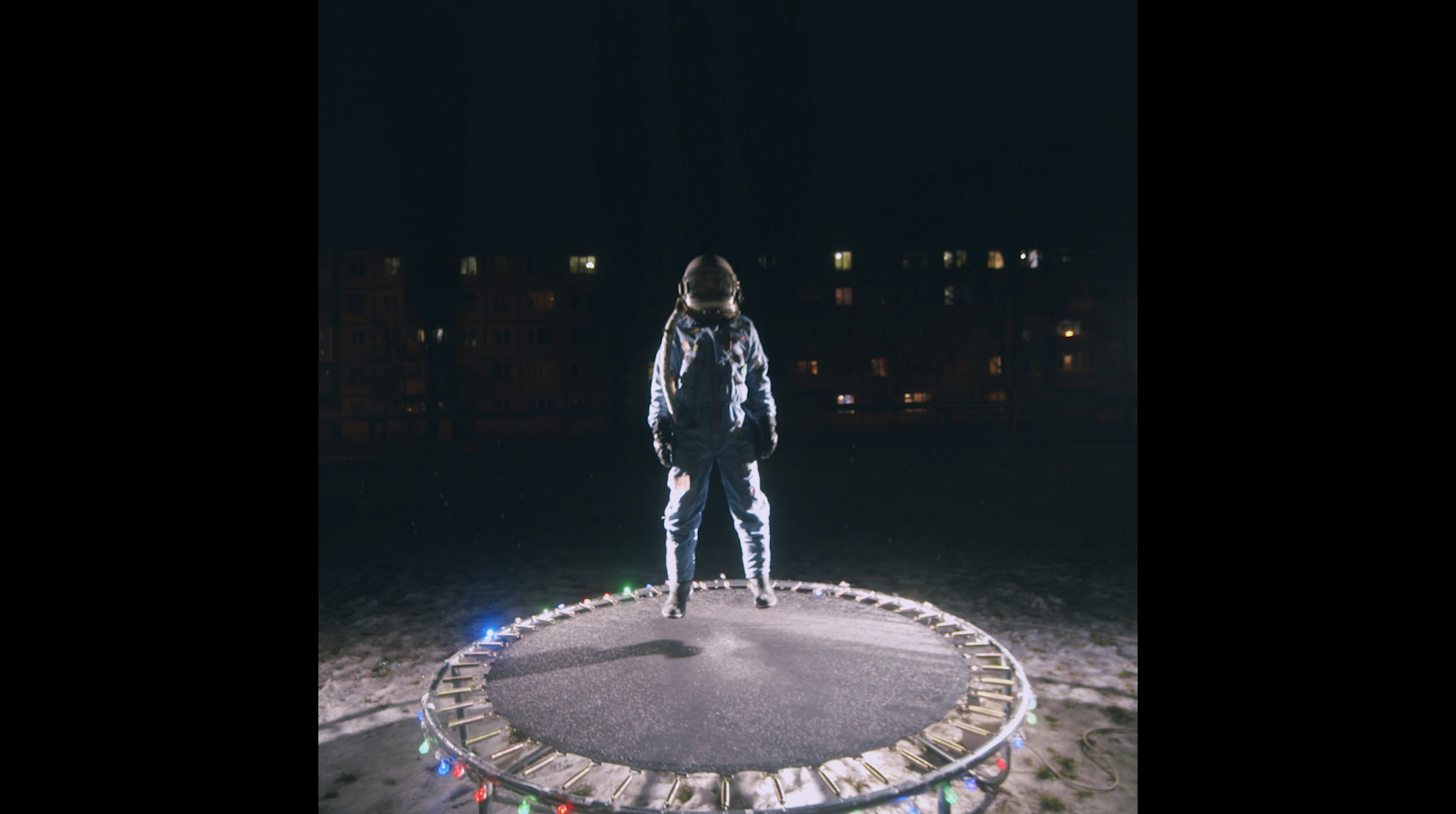“Wake Up! Daria Pugachova’s Microcosmos” by Erin Gordon
In his famous 1972 single “Starman”, David Bowie-as-Ziggy Stardust encapsulates a familiar feeling of the unknown throughout its memorable chorus: “There’s a starman waiting in the sky/He told us not to blow it/’Cause he knows it’s all worthwhile.” In a not-so-distant future, we meet the unnamed character of the astronaut from another universe in Daria Pugachova’s recent film Microcosmos. Without explicitly stating so, she interrogates the notion of home as it relates to the idea that our own individual (and often static) universes intersect and connect within a much larger one. Pugachova, an interdisciplinary artist from Ukraine, blurs the boundaries between art and life, opting to engage in participatory practices infused with daily realities; meditative introspection, personal histories, and memory are often themes found in her film work to date. She currently resides in Bulgaria, continuing to utilize performance and filmic speculation as methods to question the future, while the notion of community remains ever-present within her practice’s foundation.
Microcosmos is both a documentary underlined by the fictional character of Pugachova’s astronaut and a narrativized reflection about our own small universes within the overall unknowability of our shared universe. An overhead shot opens the film, slowly panning down towards the astronaut, who appears serene as she lays upon a thick slab of concrete. We do not know where she has come from, but even the question of her origin seems more and more insignificant as she rises to explore her new surroundings in Poltava, Ukraine. This astronaut serves as a bridge to the residents of the district, who speak on their lives, hopes, and dreams to disembodied questions that are asked offscreen; to clarify, real interviews are interspersed with snippets of the astronaut’s ongoing exploration of the district. Her own humanity is never really a question, but perhaps, her character and assumed curiosities about this new world heighten the answers of each interviewee. Upon rising, the astronaut removes her headpiece, slowly surveying this new universe with her own eyes, unobstructed. She begins to sing—acapella at a measured pace—the song “The Anthill” (“Muraveynik”) by the Soviet rock band Kino; the song calls for collective action, persistence, and strength by creating a revolution. Its lyrics culminate in an impassioned plea to “wake up,” as the camera shows women and children playing on the old playground equipment nearby. Co-founded by the late singer/songwriter Viktor Tsoy, Kino’s popularity has long expanded into former Soviet countries years after his demise in 1990 (and Kino’s subsequent breakup); the band’s messages continue to be necessary as ever due to the current war.
Poltava, the setting of Microcosmos, is nestled in the Poltava Oblast, approximately 190 kilometers (118 miles) from the Russian border and 352 kilometers (219 miles) from Kyiv, the capital of Ukraine. According to Pugachova, the invasion of Ukraine by Russia sent numerous displaced Ukrainians to Poltava for safety and shelter from the ongoing conflict. The Polovky district is a subdivision of Poltava, enveloped by towering residential buildings and the overwhelming cast of grey skies that come with the winter; a visit to a district from her childhood prompted this project, with Pugachova seeing similar qualities in Poltava and this specific district.
The first Polovky district residents we meet are a father and his two young sons, each bundled up in winter gear; the father speaks with a subtle excitement about their family’s recent relocation to the district. He remarks on the limitlessness of activities available, including the surrounding playground equipment and nearby woods for casual strolls. Shortly thereafter, Pugachova’s astronaut sits on an old spinner within the playground, using her foot to push herself into a slow swirl of movement. She walks throughout the sprawling plot throughout the overgrown weeds, and can be seen interwoven between each resident’s responses. Subsequent interviews with residents–mothers, young men, teenagers, a grandmother and her dog–reveal an overwhelming longing for something that extends beyond their universes, whether that be newfound independence, a new playground, or growing public interest in their businesses. “I’m going to visit one of the countries in our world where I’ve never been before,” remarks one young woman.
The term microcosm stems from the Greek micro kosmos, or “little world.” To think of one’s own little world evokes unintentional loneliness and a sense of longing to connect to bridge those personal worlds. The film is propelled by several interactions with residents of the surrounding buildings; for a long stretch of time, the astronaut seamlessly blends into her new surroundings in pursuit of new knowledge. For this science fiction-esque introduction to the piece to give way to these recorded interactions heightens the thematic impulses of the work itself—although the interviews are sandwiched between the astronaut’s journey, they resonate until its end and after. It proposes an inextricable intertwining between our many little universes and the universe-at-large. In this context, the residents of the Polovky district should consider expanding and shifting their own little universes.
The final ten minutes of the film segues into an intermeshing of visuals and music, with the song “Krasno-Jeltyie Dni” (“Red and Yellow Days”) joyously blaring as a montage of interviews and footage of the district whizzes by. The film’s structure is wholly intentional and a crucial piece in reading the film–especially in spite of its use of varied narrative devices. What is most captivating about Pugachova’s use of music is the decision to have the string of interactions with residents bookended by song. The interviews seemingly speak for themselves, without the interlacing documentary devices that tend to evoke emotion, such as music and interwoven images relating to the content of the interview.
Reading Pugachova’s astronaut as a mere narrative device nearly underserves the character, with the intentional choice to pose her underlying nature of newness and curiosity as a lens in which to view interviews with the residents. She surveys the environment she has arrived in, looking to the possibilities of her future through the futures conceived of by others who have been there, whether it has been for a matter of months or many years. Her universe is a dynamic one—an ever moving confluence of ideas, experiences, and stories. Her project instigates the urgency to interact with one’s environment in pursuit of a successive interaction with the next. It is inherently shaped by chance and fate, however coincidental things may seem; it is also marked by the intentional interrogation of one’s own personal history. Marked by an encounter Pugachova had with her childhood neighborhood, she realized that nothing really changes, yet people really do. As an astronaut coming to earth for the first time, she is a solitary figure in a strange, new land; she shapes her character through intentional actions and interactions with this small part of Poltava, not unlike the artist’s own semblance of childhood. With the aforementioned astronaut as the catalyst for the following events of the film, her arrival from another universe is a necessary plot device for viewing the numerous interviews with actual residents of the Polovky district. Her movements within her new environment also show an unspoken yet evident truth that she is not unlike us in spite of the suit. She teeters on the rusty playground equipment with slow careful movements, seemingly pausing to fully take in the possibility of each step–her walk through this open square, across melted snow and cracked pathways, marks the opening part of the film, which is followed by interviews and a brief return to focus yet again on the astronauts movements as night falls and Kino’s music swells.
Thus, the film fuses documentary film techniques alongside elements of science fiction and experimental film to guide thematic impulses, character development, and notes of actuality. The theoretical physicist Karen Barad equates human bodies to phenomena, ontological units that, to say in the most succinct way, are dynamically reconfiguring and re-articulating with determinacy, or, contributing to the universe’s ongoing becoming. [1] Given the ongoing invasion of Ukraine by Russia (as of this writing), viewing the work as an American from a distance and without knowledge feels especially prescient, given the continuous violation and destruction of Ukrainian infrastructure and people. However, with Pugachova’s vision of micro-universes—our discreet universes—being guided by dreams that interact, intersect, and miss completely—her role as an astronaut serves as a guided meditation through each resident’s own becomings, perhaps giving each a gentle nudge to pursue their dreams. Although the questions are never explicitly stated—nor do they need to be—part of the excitement of witnessing each answer is having a small glimpse into one’s universe by crossing an invisible boundary through the camera and answering the unspoken questions in one’s own head. We, as visual participants in Pugachova’s performance, digest those dreams with the hope that we can launch our own beyond our universes. In a recent reflection about her project, Pugachova writes, “Don’t lose your dreams and visions of the future, even when your present is war.” These dreams continue to be more invaluable than ever before.
(1) Karen Barad, Meeting the Universe Halfway: Quantum Physics and the Entanglement of Matter and Meaning (Durham: Duke University Press, 2007), 141.
Daria Pugachova is an artist, performer and art activist born in Rivne, Ukraine. She studied architecture at the Kyiv National University of Construction and Architecture. From 2013 to 2019, she played drums in the band Panivalkova. Before the war, she lived and worked in Kyiv, performing in public spaces. In her projects, Daria uses participatory practices to unite communities and integrate art into daily life. She explores the themes of the transformation of place and society through the direct presence of the artist.
In 2021, Daria received a grant for a project "Microcosmos" in Poltava, Ukraine. On February 11, the solo exhibition of the artist was opened in Jump Contemporary Art Centre. And two weeks later, Russia started a war in Ukraine.
Daria left Ukraine and traveled to Bulgaria to continue her work as an artist. She participated in Radar Sofia residency and created a new performance "I Will Close The Sky So You Could Breathe" about the war in Ukraine. During the Context AiR residency, she presented the film "Microcosmos" in front of the destroyed cinema "Cosmos" in Plovdiv. In July, together with the JUMP team and her friends who stayed in Ukraine, the artist managed to send objects for the "Microcosmos" exhibition from Poltava to Sofia.
At the moment, Poltava and its Polovky district are still intact. Despite the threat of missile attacks, the city continues to accept refugees who have moved because of the war. After February 24, life in the "microcosmos" has changed forever.




